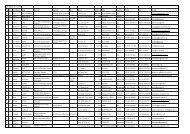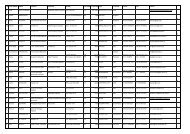icvg 2009 part I pp 1-131.pdf - Cornell University
icvg 2009 part I pp 1-131.pdf - Cornell University
icvg 2009 part I pp 1-131.pdf - Cornell University
Create successful ePaper yourself
Turn your PDF publications into a flip-book with our unique Google optimized e-Paper software.
— 41 —<br />
Fig. 2. Part of a Microsoft Access datasheet from the grapevine<br />
virus collection at Nyon.<br />
A WORLDWIDE GRAPEVINE VIRUS<br />
COLLECTION<br />
Grapevine virus collections are maintained in a<br />
number of research institutes around the world, e.g. Golino<br />
(1992). Efforts have also been made in Europe to constitute<br />
centralized collections. Massive intercontinental exchange<br />
of vine germ plasm is however not desirable. Therefore, the<br />
existence of geographically dispersed collections is likely to<br />
persist. Their funding is however not easy and rapid<br />
changes of research activities may well endanger their long<br />
term survival. Thus, any kind of common international<br />
interest or agreement would su<strong>pp</strong>ort and strengthen local<br />
efforts in this field, since international recognition generally<br />
helps to convince local financing authorities. Although<br />
<strong>part</strong>icular plant material can normally be obtained from a<br />
colleague upon a request, we know little about all the<br />
material that is available around the globe. An exchange of<br />
information and minimal standardisation would therefore be<br />
useful and assure that valuable material does not get lost,<br />
especially material that has been used in published work.<br />
Access to international grapevine virus references will also<br />
be of interest for diagnostic and phytosanitary purposes.<br />
Consequently, we propose to examine the possibility of<br />
creating an international network of grapevine virus<br />
collections.<br />
PROPOSAL<br />
(1) As a first step, we invite members of ICVG to<br />
communicate to the secretary, before the end of the year<br />
<strong>2009</strong>, their interest in sharing information about their<br />
grapevine virus collections and any useful suggestion and<br />
recommendation.<br />
(2) In the first half of 2010, <strong>part</strong>icipants provide more<br />
information about their collections, i.e. localization,<br />
organisation, use, size, owner, person in charge, some<br />
pictures as well as any other relevant information.<br />
(3) Participants provide precise data about important<br />
accessions in their collections and the type of material that<br />
could be made available: leaf samples, wood, canes, virus<br />
extracts, cDNA., antibodies, etc. This might include the<br />
expression of the willingness to conserve material for third<br />
<strong>part</strong> institutes that do not have the necessary facilities or<br />
sanitary containment. Collections of insect-proof houses or<br />
in vitro collections might be necessary in some grapevinegrowing<br />
regions.<br />
It is possible that some institutes may just indicate a<br />
link to their already existing database. Other may prefer to<br />
have information also compiled in an extra database of<br />
ICVG. The outcome is still entirely open.<br />
A special file could be opened in the ICVG homepage<br />
http://www.<strong>icvg</strong>.ch, and progress reported periodically.<br />
LITERATURE<br />
CADMAN, C. H., DIAS, H. F. & HARRISON, B. D. 1960. Saptransmissible<br />
viruses associated with diseases of grapevine in<br />
Europe and North America. Nature 187, 577-579.<br />
GOLINO, D. A. 1992. The Davis Grapevine Virus Collection. American<br />
Journal of Enology and Viticulture 43 (2), 200-205.<br />
HEWITT, W. B., RASKI, D. J. & GOHEEN, A. C. 1958. Transmission<br />
of fanleaf virus by Xiphinema index Thorne and Allen (Abstr.).<br />
Phytopathology 48, 393-394.<br />
ACKNOWLEDGEMENTS<br />
We thank N. Dubuis for extensive and accurate laboratory analysis,<br />
as well as Sabine Bonnard, Larisa Grosu, Myriam Lüchinger and Pierre-<br />
Henry Crausaz for valuable technical help in the vineyard.<br />
Progrès Agricole et Viticole, <strong>2009</strong>, Hors Série – Extended abstracts 16 th Meeting of ICVG, Dijon, France, 31 Aug – 4 Sept <strong>2009</strong>




